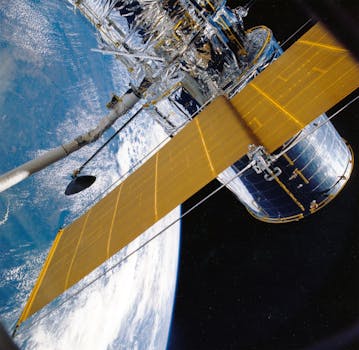
Beyond Earth: How Recent Advances in Satellite Tech are Shaping Global Communications
Satellite technology has come a long way since the launch of the first artificial satellite, Sputnik, in 1957. Today, Beyond Earth: How Recent Advances in Satellite Tech are Shaping Global Communications is a reality, with thousands of satellites orbiting the Earth, providing a wide range of services, including telecommunications, navigation, and weather forecasting. Recent advances in satellite technology are revolutionizing global communications, enabling faster and more reliable connections across the globe.
One of the key drivers of this revolution is the development of new satellite constellations, such as OneWeb and Starlink, which aim to provide global internet coverage. These constellations consist of hundreds or even thousands of small satellites, working together to provide a seamless and continuous connection. This technology has the potential to bridge the digital divide, providing internet access to remote and underserved communities around the world.
Advances in Satellite Technology
Recent advances in satellite technology have been driven by improvements in materials, design, and manufacturing processes. New materials, such as advanced composites and 3D printing, have enabled the development of lighter and more efficient satellites. Advances in design have led to the creation of more complex and sophisticated satellites, with improved propulsion systems and more efficient power generation. The use of artificial intelligence and machine learning is also becoming more prevalent in satellite technology, enabling satellites to operate more autonomously and make decisions in real-time.
Another area of advancement is in the field of satellite communications. New technologies, such as phased array antennas and high-gain antennas, have enabled faster and more reliable data transmission. The use of advanced modulation techniques, such as quadrature amplitude modulation (QAM), has also increased the efficiency of data transmission. These advances have enabled the development of new satellite-based services, such as satellite broadband and satellite-based IoT (Internet of Things) connectivity.
Impact on Global Communications
The impact of recent advances in satellite technology on global communications has been significant. Satellite-based services are now being used in a wide range of applications, including telecommunications, navigation, and weather forecasting. Satellite-based telecommunications services, such as satellite phone and satellite internet, are providing connectivity to remote and underserved communities around the world. Satellite navigation systems, such as GPS and Galileo, are providing accurate location information and timing signals, which are essential for a wide range of applications, including aviation, maritime, and land transportation.
Satellite technology is also playing a critical role in the development of the Internet of Things (IoT). Satellite-based IoT connectivity is enabling the connection of devices in remote and hard-to-reach areas, such as rural areas, oceans, and forests. This is opening up new opportunities for a wide range of applications, including agriculture, environmental monitoring, and smart cities. The use of satellite technology is also enabling the development of new services, such as precision agriculture and smart farming, which are improving crop yields and reducing waste.
Future of Satellite Technology
The future of satellite technology is exciting and rapidly evolving. New technologies, such as quantum computing and artificial intelligence, are being developed and integrated into satellite systems. The use of satellite technology is also becoming more prevalent in new areas, such as space exploration and satellite-based solar power. The development of new satellite constellations, such as OneWeb and Starlink, is also expected to continue, providing global internet coverage and enabling new services and applications.
However, there are also challenges facing the satellite industry, including the risk of collisions and debris in Earth’s orbit. The increasing number of satellites in orbit is also raising concerns about the impact on the environment and the risk of interference with other satellite systems. To address these challenges, the development of new regulations and standards is necessary, as well as the implementation of sustainable practices and technologies.




